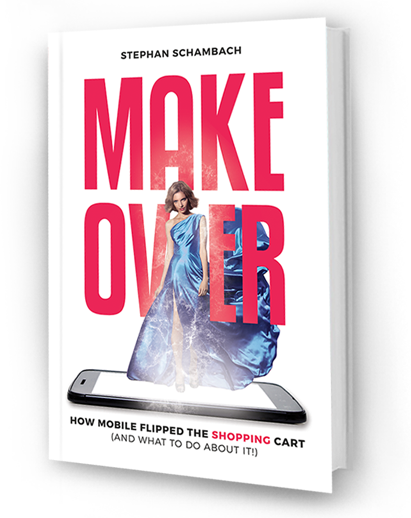
In his new book: Makeover: How Mobile Flipped The Shopping Cart (And What To Do About It!), NewStore Founder and CEO Stephan Schambach shares how the proliferation of mobile is changing retail as we know it — and how retailers must build a road map for mobile success via technology, data, loyalty programs and the brand itself.
The RTP team shares their takes on various chapters in the book — including those focused on loyalty, associates, the store, technology and consumers — to see how Schambach’s ideas relate to a number of current retail trends.
Debbie Hauss, Editor-in-Chief: Chapter 4: The Loyalty Relationship Makeover
Schambach hits the nail on the head when he talks about traditional loyalty programs vs. Loyalty 2.0. Traditional programs, while still valuable, happen outside the actual shopping experience. Loyalty 2.0 needs to take place during the shopping experience. New loyalty tactics should focus on strengthening the long-term customer relationship with the brand vs. simply offering points or discounts. That means recognizing shoppers’ desire for experiences and community. For example, offer shoppers an invite to an exclusive VIP event or the opportunity to weigh in on a product currently in development. As Schambach states, “Why settle for loyalty when you can have love?” Retailers are attaining this “love” in large part through advances in mobile technology. Via mobile, brands can communicate with customers at any time and place that is relevant for cultivating the long-term love.
Adam Blair, Executive Editor: Chapter 3: The Associate Relationship Makeover
Like most first-worlders, I go through severe withdrawal symptoms when more than 10 feet separates me from my smartphone. You will only be able to pry my phone (and my cup of coffee) out of my cold, dead hands. So it seems remarkable that retailers still need convincing about the value of letting their store associates carry mobile devices, but apparently they do. This chapter asks, “What would you think of a modern retailer that lacked a web site? You would rightly conclude that store was behind the times and not actively courting your business. Soon, that will be the reputation of retailers without mobile-enabled store associates.” I like that author Stephan Schambach notes that a positive stance on mobile enablement is now a powerful recruiting tool for associates, and also that he recommends retailers consider reconfiguring compensation so that it rewards associates for using smartphones to make sales. It’s hard to argue with the chapter’s thesis: “Store associates are mobile transformation’s front line.”
Glenn Taylor, Senior Editor: Chapter 6: The Technology Relationship Makeover
Schambach heavily emphasizes the makeover of the Chief Technology Officer, which calls for executives in this position to understand the “Hype Cycle” that all innovative technologies go through and highlights new skills necessary for the job. The chapter actually brought me back to the RIC17 panel discussion of four CIOs navigating their retail organizations through digital transformation. Several similar themes held throughout both the chapter and discussion, including: embracing partnerships instead of solo efforts; being willing to work more with outside parties; collaborating internally between departments to conduct research; and trusting an experiment during the innovation process. While every business boils down to dollar signs, CTOs/CIOs have to spearhead an attitude where failed experiments are not only okay, but necessary to discovering how to optimize a mobile shopping experience.
Klaudia Tirico, Features Editor: Chapter 2: The Store Relationship Makeover
I’m going to honest: I hate when people say the physical brick-and-mortar store is dead (or dying) because of technology. I 100% agree with Schambach when he says, “Stores, rather than being threatened by technology, will be enhanced by it.” It’s simply about tweaking the experience for a digital-savvy shopper. In this chapter, Schambach highlighted that mobile will be part of this evolution. To me, it already is. In-store capabilities like in-store WiFi, mobile POS and “skip the line” opportunities will always enhance the in-store experience and keep brick-and-mortars thriving. I recently discovered the “on-the-go” feature within the Dunkin’ Donuts app. I’ve already used the app to pay for my morning brew and earn rewards points (I get so much free coffee!), but the app also allows me to place my order before I leave the house, so I can skip the line, go straight to the “pick up” area and get my coffee right away. It’s a life saver! The convenient opportunities that mobile can provide with the in-store experience seem endless, and retailers need to definitely start thinking about how to leverage mobile more if they aren’t already.
Matt Halchak, Editorial Intern: Chapter 1: The Consumer Relationship Makeover
Schambach starts out Makeover by exploring the relationship between consumers and retailers, and how mobile commerce is changing the game. He outlines a series of factors that are essential for creating customer engagement in the mobile age, including two that I strongly agree with and one I’m not quite sold on. First, Schambach emphasizes the importance of simplicity, and I could not agree more — simplicity is king. When a retailer has a web site or app that makes it quick and easy to navigate, find important information (like product reviews or sizing information), and pay, it makes users more likely to come back. Second, Makeover discusses rewarding customer loyalty. Whether that means point systems, exclusive member opportunities or other features, I think Schambach is spot-on when he says that it helps build better customer relationships. I was less sold on his emphasis on the “connection between mobile and social.” I think the social component of shopping in a store has not yet been re-created in the mobile realm, and don’t think features like “scanning an item and showing it off to a friend by way of a live video” quite bridge that gap. Perhaps re-creating the social experience on mobile will be the next big breakthrough.






